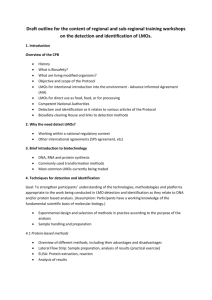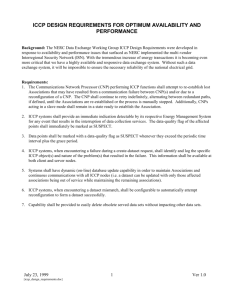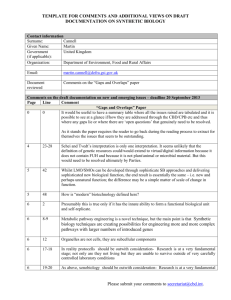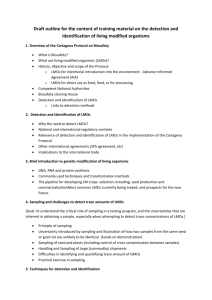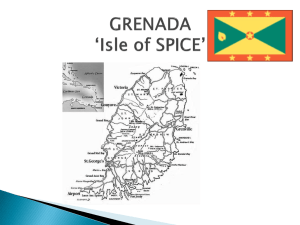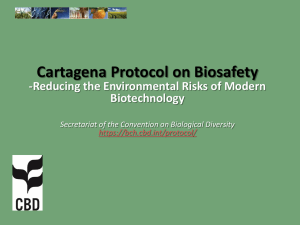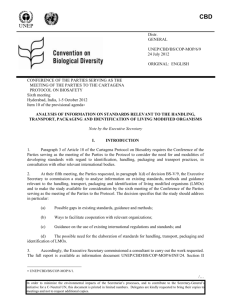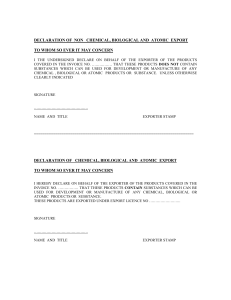English
advertisement
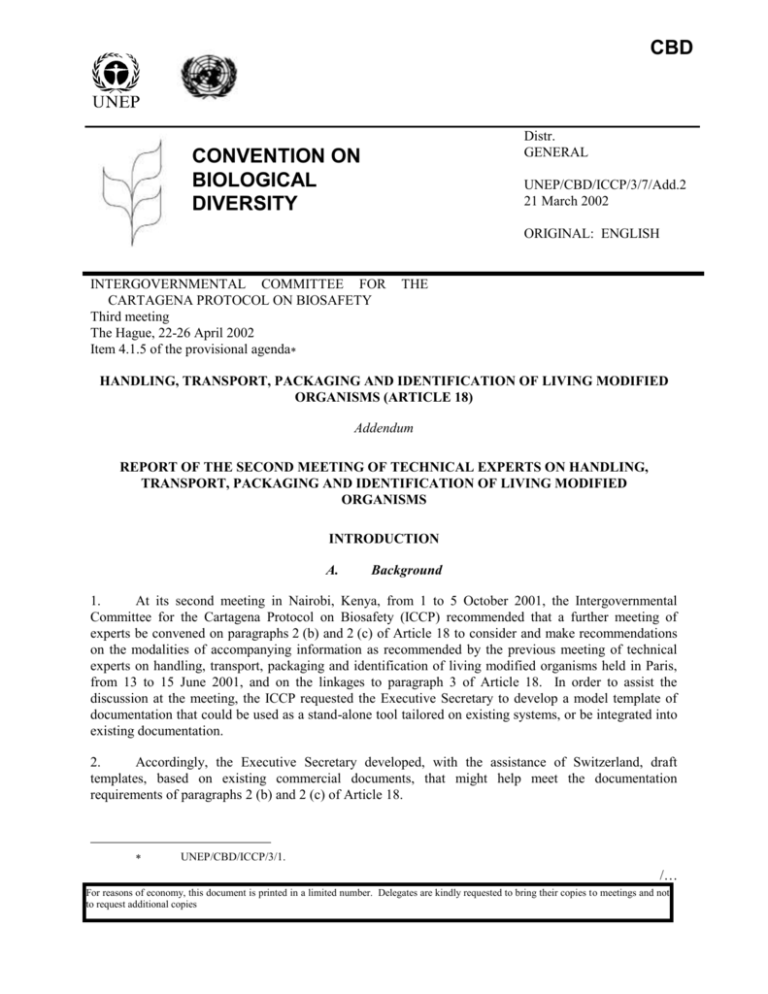
CBD Distr. GENERAL CONVENTION ON BIOLOGICAL DIVERSITY UNEP/CBD/ICCP/3/7/Add.2 21 March 2002 ORIGINAL: ENGLISH INTERGOVERNMENTAL COMMITTEE FOR CARTAGENA PROTOCOL ON BIOSAFETY Third meeting The Hague, 22-26 April 2002 Item 4.1.5 of the provisional agenda THE HANDLING, TRANSPORT, PACKAGING AND IDENTIFICATION OF LIVING MODIFIED ORGANISMS (ARTICLE 18) Addendum REPORT OF THE SECOND MEETING OF TECHNICAL EXPERTS ON HANDLING, TRANSPORT, PACKAGING AND IDENTIFICATION OF LIVING MODIFIED ORGANISMS INTRODUCTION A. Background 1. At its second meeting in Nairobi, Kenya, from 1 to 5 October 2001, the Intergovernmental Committee for the Cartagena Protocol on Biosafety (ICCP) recommended that a further meeting of experts be convened on paragraphs 2 (b) and 2 (c) of Article 18 to consider and make recommendations on the modalities of accompanying information as recommended by the previous meeting of technical experts on handling, transport, packaging and identification of living modified organisms held in Paris, from 13 to 15 June 2001, and on the linkages to paragraph 3 of Article 18. In order to assist the discussion at the meeting, the ICCP requested the Executive Secretary to develop a model template of documentation that could be used as a stand-alone tool tailored on existing systems, or be integrated into existing documentation. 2. Accordingly, the Executive Secretary developed, with the assistance of Switzerland, draft templates, based on existing commercial documents, that might help meet the documentation requirements of paragraphs 2 (b) and 2 (c) of Article 18. UNEP/CBD/ICCP/3/1. /… For reasons of economy, this document is printed in a limited number. Delegates are kindly requested to bring their copies to meetings and not to request additional copies UNEP/CBD/ICCP/3/7/Add.2 Page 2 3. Following the generous financial contribution by the Governments of Canada, France and Japan, a Meeting of the technical experts was held at the premises of the International Civil Aviation Organization (ICAO) in Montreal, from 13 to 15 March 2002. B. Attendance 4. Participants in the Meeting were selected from among government-nominated experts from each geographic region with a view to achieving a balanced regional distribution. In addition, representatives of competent intergovernmental and non-governmental organizations, as well as stakeholders were invited to participate. 5. The Meeting was attended by experts nominated by the following Governments: Antigua and Barbuda, Argentina, Australia, Austria, Brazil, Cameroon, Canada, China, Croatia, Egypt, France, Ghana, Hungary, India, Iran (Islamic Republic of), Japan, Lithuania, Mexico, Namibia, Niger, Norway, Pakistan, Peru, Poland, Republic of Korea, Slovenia, Sweden, Switzerland, United Kingdom of Great Britain and Northern Ireland, United States of America. 6. The meeting was also informed that experts from Dominican Republic, Honduras, Jamaica, Malaysia and Nigeria, who had earlier confirmed that they would be attending, could not do so due to last minute, unforeseen circumstances. 7. A representative of the European Community also attended. 8. Representatives of the following intergovernmental and non-governmental organizations and other stakeholders also participated in the Meeting: (a) Intergovernmental organizations: International Civil Aviation Organization (ICAO), Codex Alimentarius Commission of the Food and Agricultural Organization of the United Nations (FAO) and the World Health Organization (WHO), Organisation for Economic Co-operation and Development (OECD), United Nations Environment Programme (UNEP); (b) Non-governmental organizations and other stakeholders: Global Industry Coalition; Greenpeace International; International Seed Trade Federation (FIS/ASSINSEL); SOLAGRAL; Third World Network. ITEM 1. OPENING OF THE MEETING 9. The meeting was opened by Mr. Olivier Jalbert, on behalf of the Executive Secretary of the Convention on Biological Diversity, at 10 a.m. on Wednesday, 13 March 2002. 10. In his opening statement, Mr. Jalbert welcomed, on behalf of the Executive Secretary, the participants and said that this meeting had been convened, at the request of the Intergovernmental Committee for the Cartagena Protocol on Biosafety (ICCP), to consider the possible modalities that would help the Parties meet the information requirements for documentation under paragraphs 2 (b) and 2 (c) of Article 18 as well as linkages to paragraph 3. He expressed his gratitude to the Governments of Canada, France and Japan for their support of the participation of experts from developing countries and to the Governments of Canada and France for hosting and co-hosting the Meeting. He also thanked Switzerland for its assistance in developing templates for the Meeting as well as the OECD, the UN SubCommittee for the Transport of Dangerous Goods and the World Trade Organization (WTO) for the information that they provided. He stressed that the recommendations from this meeting would contribute significantly to the preparations necessary for the implementation of the requirements of Article 18 upon entry into force of the Protocol. /… UNEP/CBD/ICCP/3/7/Add.2 Page 3 11. Opening statements were also made by Mr. Barry Stemshorn, Deputy Assistant Minister of the Environment, Canada, and Mr. Paul Luu, of the Ministry of Agriculture and Fisheries, France, host and co-hosts of the meeting. 12. In his statement, Mr. Stemshorn welcomed the participants to Montreal and thanked the Secretariat for its work in preparing for the meeting. He recalled that Canada has been actively involved in the progress of the Protocol, from the decision to proceed with the initiative in Madrid in 1995 up to its adoption in Montreal in 2000. He noted that the requirements for documentation under paragraphs 2 (b) and 2 (c) of Article 18 of the Protocol were important to the questions of handling, packaging, transport and identification; and that clarification was being sought, both by countries considering ratification of the Protocol and by those which had already ratified it. He observed that it was at this point that the Protocol meshed with international trade. Borrowing from the text of the preamble of the Protocol, he stressed that recognizing that trade and environment agreements should be mutually supportive with a view to achieving sustainable development was probably the best general statement of the mission of this meeting of experts. In closing, he assured the Meeting that Canada was supportive of the task before it and that with the spirit of cooperation, which has characterized the work of the Protocol, the meeting should be successful in achieving its goal. 13. In his statement Mr. Luu warmly thanked Canada for having renewing the experience of a joint organized event and for hosting the meeting. He noted that Ambassador Zeller had expressed the wish at the Paris meeting that such cooperation with a transatlantic party would not be an isolated case. He was also pleased that Japan had joined in as well. Such participation was another example of France’s commitment to work with other countries on the complex issue of biotechnology. He expressed the hope that on the basis of the work already done at the Meeting in Paris, and confirmed by the ICCP in Nairobi, that the current meeting of technical experts would produce operational recommendations that could be adopted by the ICCP at its third meeting. ITEM 2. ORGANIZATIONAL MATTERS 2.1. Election of officers 14. As the opening session of the meeting, on 13 March 2002, participants approved the following officers: Chair: Mr. Paul Luu (France) Co-Chair: Mr. P.K. Ghosh (India) Rapporteur: Mr. George Rhodes (Namibia) 2.2. Adoption of the agenda 15. The Meeting adopted the following agenda on the basis of the provisional agenda (UNEP/CBD/BS/TE-HTPI/2/1). 1. Opening of the meeting. 2. Organizational matters: 2.1 Election of officers; 2.2 Adoption of the agenda; /… UNEP/CBD/ICCP/3/7/Add.2 Page 4 2.3 3. Organization of work. Consideration of modalities of information requirements for accompanying documentation under paragraphs 2 (b) and 2 (c) of Article 18, including linkages to paragraph 3 of Article 18, for: 3.1. Documentation accompanying living modified organisms that are destined for contained use (Article 18, paragraph 2 (b)); 3.2. Documentation accompanying living modified organisms that are intended for intentional introduction into the environment (Article 18, paragraph 2 (c)). 4. Recommendations. 5. Other matters. 6. Adoption of the report. 7. Closure of the meeting. 2.3. Organization of work 16. Following a discussion, the Meeting agreed to consider the items of the agenda in their customary order, and hold a general debate on item 3, in plenary. It was decided not to break into two groups to consider issues under agenda item 3.1 (Documentation accompanying living modified organisms that are destined for contained use (Article 18, paragraph 2 (b)); and agenda item 3.2 (Documentation accompanying living modified organisms that are intended for intentional introduction into the environment (Article 18, paragraph 2 (c)). ITEM 3. 17. CONSIDERATION OF MODALITIES OF INFORMATION REQUIREMENTS FOR ACCOMPANYING DOCUMENTATION UNDER PARAGRAPHS 2 (b) AND 2 (c) OF ARTICLE 18, INCLUDING LINKAGES TO PARAGRAPH 3 OF ARTICLE 18 Agenda item 3 was initially taken up in plenary at the 1st session, on Wednesday, 13 March 2002 18. A representative of the Secretariat introduced the note of the Executive Secretary on the modalities of information requirements for accompanying documentation under paragraphs 2 (b) and 2 (c) of Article 18 (UNEP/CBD/BS/TE-HTPI/2/2). The document included draft templates for documentation that could be integrated into existing documentation systems. The note also summarized the submissions of those international agencies that had responded to the invitation of the ICCP to submit statements about possible areas of cooperation and/or coordination in the implementation of measures required under paragraphs 2(b) and 2 (c) of Article 18. Some organizations had not yet responded, but were expected to do so in the future. The representative of the Secretariat noted that a submission from the Global Industry Coalition was being circulated to the technical experts for their information. 19. The Chair thanked the Secretariat and Switzerland for their preparations and asked the representatives of the international organizations present at the meeting to briefly outline their contributions. 20. The representatives from the following organizations took the floor to introduce their submissions: OECD, Codex Alimentarius Commission and the Global Industry Coalition. /… UNEP/CBD/ICCP/3/7/Add.2 Page 5 21. The Chair then called on Mr. Francois Pythoud, Switzerland, to present the draft templates (UNEP/CBD/BS/TE-HTPI/2/2, annexes I and II). 22. Mr. Pythoud observed that the draft model templates were in some aspects similar to the proposals put forward by the Global Industry Coalition. He noted that his presentation consisted of a Pro Forma Invoice that incorporated both the essential requirements of paragraphs 2 (b) and 2 (c) of Article 18, as well space for additional information. 23. The Chair then opened the floor for a general discussion of the modalities of information required for accompanying documentation under Article 18, paragraphs 2 (b) and (c). 24. Statements were made by the experts from Argentina, Australia, Austria, Cameroon, Canada, India, the Islamic Republic of Iran, Namibia, Norway, the United States of America, and OECD. 25. The following main points were raised: (a) The distinction between the information requirements of paragraphs 2 (b) and 2 (c); (b) The need for a unique identifier with linkages to the Biosafety Clearing-House; the lack of a generally applicable unique identifier at this time; (c) The distinction between LMOs destined for commercial use and those for research; (d) The possibility of including the category or name of the LMO in the documentation; (e) The need for a document that was both simple and clear; (f) The need to not overstep the wording of the Protocol; (g) The need for documentation to avoid unnecessary disruption of trade; and (h) The need to concentrate on those features which will be immediately required when the Protocol entered into force. 26. At the 2nd plenary session, the Chair noted the requirement that the experts work within the mandate provided by the ICCP and observed that the information required was that which will be used by all those who will handle the shipments of LMOs and not just specialists. Identification as LMOs 27. The Chair then proposed that the meeting concentrate on the draft templates, looking first at those elements that were common to both paragraphs 2 (b) and 2 (c), and then at those points where they differed, bearing in mind the requirement that the nature and form of the information required in the accompanying documentation is to be simple, visible, legible and adequate. He then asked the experts to begin by discussing that the requirement the LMOs be identified in the documentation. 28. Statements were made by the experts from Australia, Austria, Brazil, Cameroon, Canada, China Croatia, Egypt, the European Community, India, the Islamic Republic of Iran, Japan, Mexico, Namibia, Norway, Poland, Switzerland, the United Kingdom of Great Britain and Northern Ireland, and the United States of America, and by the representative of the Global Industry Coalition. 29. The following main points were raised: /… UNEP/CBD/ICCP/3/7/Add.2 Page 6 (a) The need for information which could be scientifically verified; (b) The fact that most LMOs for research and for field trials would not have a unique identifier before they had received national approval; (c) That the issue of commercial use versus research use was really a question of scale; (d) That contained use could not be specified in detail; (e) The need for a definition of contained use for the purposes of biosafety; (f) the Protocol; (g) (h) shipped; That such a definition of contained use is already set out in Article 3, paragraph (b), of The need to avoid redundant information; That current documentation already required disclosure of the nature of the LMOs being (i) That paragraph 2 (b) of Article 18 does not require disclosure of the name of the LMO; (j) That if the documentation is too simple it may not be useful; (k) That the accidental introduction of LMOs into the environment could have serious consequences; (l) That port authorities would not be able to interpret detailed scientific information; (m) legislation; That if more detailed information is needed, it can be required by way of national (n) assessment; That there was a need to identify LMOs for shipping documentation and not for risk (o) That there was no mention of research in the text of the Protocol at Article 18 and that it would not be appropriate to go beyond the wording of the text of the Protocol. 30. The Chair summarized the discussion. He noted that there was agreement on the need to mention LMOs in the documentation that would accompany a transboundary shipment. He asked the technical experts to consider the suggestion that the documentation go further and name the category of LMO that was being shipped. He also asked whether the technical experts would want to consider making a distinction between LMOs which were destined for commercial use and those for research. The Chair stressed however that there was a need for additional information over and above that which was already provided in the existing documents. He observed that most of the discussion had dealt with the possibility of using existing documentation but noted that in the future new documentation might be required. He reminded the Meeting that there was a clear requirement for a document that could be used as soon as the Protocol comes into force. Requirements for the safe handling, storage, transport and use 31. The Chair then raised the issue of the requirement for the safe handling, storage, transport and use of LMOs as required by paragraphs 2 (b) and 2 (c) of Article 18. /… UNEP/CBD/ICCP/3/7/Add.2 Page 7 32. Statements were made by the experts from Australia, Austria, Cameroon, Canada, the European Community, India, Norway, Sweden, the United Kingdom of Great Britain and Northern Ireland, the United States of America, OECD and the Global Industry Coalition. 33. The following main points were raised: (a) The possibility of adapting existing international regulations; (b) The advisability of using the United Nations system for the transport of dangerous goods; (c) That any requirements based on domestic regulatory frameworks need to be consistent with international obligations; (d) The fact that most LMOs could not be classified as dangerous goods; (e) That different LMOs required different treatment; (f) The need for linkages to paragraph 3 of Article 18; (g) The need to prioritize those elements needed for the implementation of the Protocol; (h) That the issue of use is not always covered by other standards; (i) The need to ensure the safe handling of LMOs; (j) The need to identify LMOs for shipping purposes and not duplicate information already provided for risk assessment through the advance informed agreement procedure and the need for a survey of current practice; (k) That if the issue had been considered and no special requirements were necessary, then this should be noted in the document. 34. A representative of the Secretariat pointed out that a synthesis of existing practices on handling had already been made by the Secretariat and that the Conference of the Parties serving as the meeting of the Parties to the Protocol would be given a revised version when it addressed this issue. 35. The Chair noted that the Secretariat was to update its existing document for the Conference of the Parties serving as the meeting of the Parties to the Protocol. He observed that there was a need to ensure that documents were adequately completed, and that if there were no specific indications for handling LMOs, then this should also be entered on the document. The Chair then raised the issue of the need to indicate a contact point for further information on any documents accompanying the LMOs. Contact point for further information 36. Statements on this issue were made by experts from Antigua and Barbuda, Australia, Namibia, Norway, the United Kingdom of Great Britain and Northern Ireland, the Global Industry Coalition and the Third World Network. 37. The following main points were raised: (a) That there were a number of possible contact points; (b) That the contact point needed to provide information in sufficient detail about the LMO; /… UNEP/CBD/ICCP/3/7/Add.2 Page 8 (c) That the contact point needed to be able to provide sufficient information about safe handling to allow any incidents to be dealt with; (d) That the contract point could be either the exporter or the importer; (e) That when consent from a national authority is needed for import of an LMO, a reference to the permit and contact point of the competent authority be included in the transport documentation; (f) template; That it would be useful to have a specific section for the contact point on the draft model (g) That a duplication of documentation should be avoided; (h) That capacity-building should be taken into account; (i) That the contact point should be that person most knowledgeable about the shipment; (j) That it was an obligation under the Protocol to name a contact point. and 38. The Chair observed that for the purposes of paragraph 2 (b) of Article 18, either the importer or the exporter could function as the contact point for further information. Name and address of the individual and institution to whom the LMOs are consigned 39. The Chair then asked the experts to begin to consider the issue of the name and address of the individual or institution to whom the LMOs are consigned. 40. Statements were made by experts from Namibia, Norway, the United Kingdom of Great Britain and Northern Ireland, the Global Industry Coalition the Third World Network. 41. The following main points were raised: (a) That the term consignee is used in the text of paragraph 2 (b), but not paragraph 2 (c), of Article 18; and (b) That there is a need to identify the final destination of the LMOs. 42. At the 3rd plenary session, the Chair noted that much of the previous session had been spent discussing the information needed for the documents required both under paragraphs 2 (b) and 2 (c) of Article 18. He therefore proposed that the experts conclude their discussion of these requirements at this session and commence the discussion of the types of information which could fulfil the additional requirements of paragraph 2 (c) of Article 18. He suggested that this discussion then be continued at the 4th plenary session where the experts would also discuss the linkage to paragraph 3 of Article 18. 43. The Chair then asked the participants to continue to address the issue of the consignee. 44. Statements were then made by experts from Australia, Cameroon, Norway, the United States of America, the Global Industry Coalition and the Third World Network. 45. The following main points were raised: (a) That there was a need to establish the most appropriate contact person on a case-by-case basis; /… UNEP/CBD/ICCP/3/7/Add.2 Page 9 (b) That the exporter was likely to have more knowledge than the importer; (c) That the consignee would need to know how to handle the LMOs that were being received, that either the importer or the consignee would be able to direct inquires to the exporter; (d) That the names of both the exporter and the importer would appear on most documents. 46. The Chair observed that it seemed from the discussion that the consignee’s address would generally be that of the importer. The Chair also noted that there had been little discussion of the need to include the name and address of the importer and exporter, as appropriate, in any documentation to accompany the transboundary shipment of LMOs. He remarked that the inclusion of such information was in conformity with the requirements of Article 18. Declaration that “the movement is in conformity with the requirements of the Protocol applicable to the exporter” 47. The Chair then asked the participants to consider the issue of the inclusion in the documentation of a declaration that the transboundary movement of the LMO is in conformity with the requirements of the Protocol. 48. Statements were made by the experts from Australia, Croatia, the European Community, India, Norway, the United States of America, and the Global Industry Coalition. 49. The following main points were raised: (a) protocol; The need to take into consideration the notification requirements under Article 8 of the (b) That the declaration should apply only with respect to the first country of import; (c) That the declaration include a reference that AIA procedures had been followed; (d) That an AIA reference number be included; (e) That the AIA procedure applied to the Parties and not to the exporter; (f) exporter; That the AIA procedure is an obligation of the Parties and so an obligation of the (g) That each Party will develop legislation that all importers and exporters will follow; (h) That the exporter should not be required to ensure that all AIA procedures had been met; (i) That there will be States not party to the Protocol; (j) Whether there was a need for a signed declaration; (k) That the declaration required under paragraph 2 (c) of Article 18 applied to all subsequent transport of LMOs; (l) That the declaration should adopt the exact wording of paragraph 2 (c) of Article 18; (m) That the exporter could only certify that a shipment was in accordance with the requirements applicable to the exporter. /… UNEP/CBD/ICCP/3/7/Add.2 Page 10 Identity and relevant traits and/or characteristics specified 50. The Chair stressed that on this issue that it was important to stick to wording of the Protocol. The Chair then addressed the final information requirement, the need to identify the LMOs as LMOs and the need to specify the identity, and any relevant traits and/or characteristics. The Chair noted that while it was possible to use either a unique identifier or those references generated by the AIA process, there could be cases that were not covered by either of these options. 51. Statements were made on this issue by the experts from Argentina, Australia, Austria, Brazil, Canada, Cameroon, Egypt, the European Community, India, the Islamic Republic of Iran, Japan, Mexico, Namibia, Norway, the Republic of Korea, Sweden, Switzerland, the United States of America, the Global Industry Coalition and Greenpeace International. 52. The following main points were raised: (a) That the aim of identification was to provide the handler with sufficient information to deal with unexpected incidents; (b) relevant; That a unique identifier or a reference to a harmonized code should be included where (c) That there should be a link to relevant information at the Biosafety Clearing House; (d) That there were linkages to Article 8 and Annex I of the Protocol; (e) That an AIA reference should be included where applicable, (f) That the AIA procedure may not apply where the simplified procedure is used under Article 13 of the Protocol; (g) That Annex I applied to both Articles 8 and 13 of the Protocol; (h) That there could be a reference to national permits; (i) information; That if permits were to referred to then must be both accessible and contain relevant (j) That there was a need for a short description of the LMO; (k) That there was a need for simple examples of documents; (l) That there was a need to note the novel genotype and phenotype of the LMO; (m) That these shipping documents would be referred to at national borders and that there was no need for detailed scientific information; (n) That events of transformation be included in the shipping documents; (o) That information requirements varied from country to country; (p) That, for Article 18, only the taxonomic or category name should be required with a brief description of the relevant characteristics. /… UNEP/CBD/ICCP/3/7/Add.2 Page 11 53. The Chair reviewed the discussion and noted that there seemed to be basic agreement that a certain amount of information was in most cases covered by the identity and relevant traits that must in any case be given. He also noted that a reference to a permit issued under the AIA procedure would be valuable, while a reference to a unique identifier could be part of the document as well. He observed that in many cases the LMOs would only be identified by name. 54. The Chair opened the 4th plenary session by drawing the attention to the participants to the language of Annex I of the Protocol. He asked whether any of its provisions could be used as a starting point for a more precise description of the LMOs for transboundary shipment. 55. Statements were made by the experts from Austria, Australia, Brazil, Cameroon, Canada, Egypt, the European Community, India, the Islamic Republic of Iran, Norway, Poland, Switzerland, and the United States of America, and by the representatives of the Global Industry Coalition, Greenpeace International and the Third World Network. 56. The following main points were raised: (a) That all of the elements were important, that information on all of the elements should be available on request; (b) That only a basic description of the LMO was needed; (c) That only the commonly understood international name of the LMO should be used; (d) That some of this information would be unnecessary for border personnel; (e) That the document circulated by the Global Industry Coalition was a useful starting (f) That the promoter or vector used in the modification should be included; point; (g) That the name(s) of the gene(s), promoter(s), and/or plasmid(s) as the case may be, and their source(s) be included under the description of the LMO; (h) That the promoter and other suggested elements may be proprietary information; (i) That while the promoter is important to risk assessment it is not necessary after approval and the AIA procedure are completed; (j) That while the promoter was important to risk assessment, it was not necessary after that point for the port authorities; (k) That paragraph 3 of Article 21 created a requirement for the Parties to protect confidential information; (l) That such information is generally the subject of patents; (m) That port authorities only require a taxonomic name or strain, with a reference to the characteristics of the donor organism; (n) That detailed information is important for risk assessment but not for transborder shipment; and /… UNEP/CBD/ICCP/3/7/Add.2 Page 12 (o) That sufficient information should be available to aid a technical expert in the assessment of the LMO. 57. The Chair noted that while some participants would like more information included in the description of LMOs than some of the other participants, it was not that much more and he observed that that this difference could be reflected in the final report. 58. Mr. Pythoud then reintroduced the modified draft templates to the participants and described the elements required by paragraphs 2 (b) and 2 (c) of Article 18. 59. Statements were made by the experts from Australia, Austria, Cameroon, Egypt, European Community, India, Namibia, Norway, Poland, and the representative from Greenpeace International. 60. The following new points were raised: (a) That the templates had to address why an LMO is an LMO and how is it to be identified; (b) That information on the final destination of the LMO was required; (c) The utility of a pro forma invoice; (d) The need for specific information on the traits of LMOs; (e) shipment; The need for linkage between certifying the identity of the LMO and the content of a (f) The need for a separate box in the document for the harmonized code; (g) That the harmonized code was not mandatory; (h) That invoices were not usually signed; (i) That there was no requirement for a signed declaration in paragraph 2 (b) of Article 18; and (j) That only certain items marked on the draft templates, indicated in red, could be considered mandatory. 61. The Chair noted that the Meeting would continue to address this issue when the revised documents were reviewed at the next plenary session. He asked the participants to address the issue of the linkages between paragraphs 2 (b) and 2 (c) and paragraph 3 of Article 18 before the close of the current session. 62. Statements were made by the experts from Argentina, Australia, China, the European Community, India, Norway, and the United States of America and the representative from the Third World Network. 63. The following main points were raised: (a) That this linkage would only be important once the Protocol enters into force; (b) That the standard established should be a unique identifier connected to the Biosafety Clearing-House; /… UNEP/CBD/ICCP/3/7/Add.2 Page 13 (c) operational; That the only unique identifier at the moment was that of the OECD, which was not yet (d) That the Secretariat should do a study on unique identifiers; (e) That such a request must come from the ICCP; (f) That there was a need to wait and see what regulatory gaps would develop; (g) That there was a need to identify existing regulatory gaps; (h) That there was a need to see how the Protocol worked before taking any decisions on whether standards are needed; (i) That there were more urgent issues for the Secretariat to work on than unique identifiers; (j) That the issue of unique identifiers should be considered by the Conference of the Parties serving as the meeting of the Parties to the Protocol and not the ICCP; (k) That clarification was required on existing standards; (l) That there were already LMOs in circulation; and (m) That the recommendations to the ICCP should prioritize those elements that needed to be addressed urgently. 64. The Chair noted that as the meeting was one of technical experts, all that it could do was make a list of recommendations. It could not say which of these recommendations was more urgent than any other for the ICCP. ITEM 4. RECOMMENDATIONS 65. At its 5th plenary session, on Friday 15 March 2002, the Meeting considered the draft recommendations, prepared by the Chair on the basis of the outcome of the deliberations. 66. Following a discussion, a number of experts were of the opinion that the Meeting did not have the expertise to provide advice on the need for a signed declaration, or who should sign it. It was suggested that a possible way forward on this issue would be for the Secretariat to seek legal advice on the implications of a signature, or lack of it, on the declaration 67. After further discussion the, the Chair informed the Meeting that he would revise draft text of the recommendations in light of the views expressed by the experts. 68. At its 6th plenary session, the Meeting continued its discussion of the revised draft recommendations submitted by the Chair. 69. The Meeting adopted the draft recommendations, as amended in the course of the discussion, for transmission to the ICCP at its third meeting. The text of the recommendations is annexed to the present report. ITEM 5. 70. OTHER MATTERS No other matters were raised for discussion. /… UNEP/CBD/ICCP/3/7/Add.2 Page 14 ITEM 6. ADOPTION OF THE REPORT 71. The present report was adopted on 15 March 2002, on the basis of the draft report presented by the Rapporteur. ITEM 7. CLOSURE OF THE MEETING 72. Following the customary exchange of courtesies, the meeting was closed 7:45 p.m. on Friday, 15 March 2002. /… UNEP/CBD/ICCP/3/7/Add.2 Page 15 Annex RECOMMENDATIONS FOR CONSIDERATION BY THE INTERGOVERNMENTAL COMMITTEE FOR THE CARTAGENA PROTOCOL ON BIOSAFETY (ICCP) AT ITS THIRD MEETING The Meeting of Technical Experts on Handling, Transport, Packaging and Identification of Living Modified Organisms (paragraphs 2(b) and 2(c) of Article 18), Having met for the second time to consider modalities of information requirements for accompanying documentation under paragraphs 2 (b) and 2 (c) of Article 18 of the Biosafety Protocol and linkages with paragraph 3 of the same Article, Recognizing that different views, as reflected in the report of the meeting, were expressed by a number of experts with regard to the extent of necessary information according to paragraphs 2 (b) and 2 (c) of Article 18 or the potential need for additional information (in the sections highlighted by an * in the text) that would assist further in the implementation of paragraphs 2 (b) and 2 (c) of Article 18, Submits the following recommendations regarding information to be provided for the implementation of paragraph 2 (b) and 2 (c) of Article 18, for consideration by the Intergovernmental Committee for the Cartagena Protocol on Biosafety: 1. That the following information be provided to meet the requirements for documentation under paragraph 2 (b) of Article 18: (a) (b) (c) *Clear identification as “living modified organisms”: (i) As destined for contained use; (ii) Name of the organisms; Specification of requirements for the safe handling, storage, transport and use: (i) As provided under applicable existing international requirements, such as the United Nations Model Regulations on the Transport of Dangerous Goods; (ii) As provided under domestic regulatory framework, if any; (iii) Any other requirements agreed to by the importer and exporter; or (iv) In the event there is no requirement, indicate that there is no specific requirement; Contact point for further information: An individual or organization in possession of relevant information such as the exporter, importer or consignee, as appropriate, including contact details necessary to reach them as fast as possible especially in case of emergency; (d) Name and address of the individual and institution to whom the living modified organisms are consigned. 2. The following information be provided to meet the requirements for documentation under paragraph 2 (c) of Article 18: /… UNEP/CBD/ICCP/3/7/Add.2 Page 16 (a) Clear identification as “living modified organisms”; (b) Specification of identity and relevant traits and/or characteristics as specified in the Protocol and as identified in common practices: (i) A brief description of the organisms, including category, name, relevant traits including transgenic traits, and characteristics such as event(s) of transformation; (ii) *Where available and applicable: A reference to a system of identification, for instance: A reference may be made to harmonized code such as unique identifier; Notification under the advance informed agreement procedure; Final decisions; Notifications to the Biosafety Clearing-House; (c) (d) Other requirements in accordance with the regulatory status of the LMO in the Party of import. Any requirements for the safe handling, storage, transport and use: (i) As provided under applicable existing international requirements, such as the requirements under the OECD Seed Schemes; (ii) As provided under domestic regulatory framework, if any; (iii) Any other requirements agreed to by the importer and exporter; (iv) As provided under the advanced informed agreement procedure if applicable; or (v) In the event there is no requirement, indicate that there is no specific requirement; Contact point for further information: An individual or organization in possession of relevant information such as the exporter or importer, as appropriate, including contact details necessary to reach them as fast as possible especially in case of emergency; (e) Name and address of the exporter and importer; (f) A declaration that the transboundary movement is in conformity with the requirements of the Cartagena Protocol on Biosafety applicable to the exporter. 3. In the context of the implementation of the provisions of paragraphs 2 (b) and 2 (c) of Article 18 as soon as the Protocol enters into force, the ICCP: /… UNEP/CBD/ICCP/3/7/Add.2 Page 17 (a) Pending consideration of the need to develop a stand-alone template, urges Parties and Governments to take the necessary measures with a view to include information requirements pertaining to paragraphs 2 (b) and 2 (c) of article 18 indicated in recommendations 1 and 2 above, into existing documentation practices accompanying living modified organisms supplied by the originator of the shipment (e.g. commercial invoices). Examples of such possible integration are illustrated in the templates appended to this recommendation; (b) Encourages Parties to consider whether the provision of additional information, especially the intended use of the living modified organisms, e.g, “research” or “commercial”, if relevant to biosafety, and if not already specified on the accompanying documentation, would facilitate implementation of paragraphs 2 (b) and 2 (c) of Article 18. 4. With regard to linkages of paragraphs 2 (b) and 2 (c) of Article 18 to paragraph 3 of Article 18, ICCP considers: (a) Requesting the Executive Secretary to continue to collect and review existing information on standards, practices and rules relevant to handling, packaging, transport and identification of LMOs, including the ongoing processes on these matters under relevant international organizations, and operational experience of movements of LMOs under paragraphs 2 (b) and 2 (c) of Article 18 of the Protocol, with a view to assisting consideration of this issue by the Conference of the Parties serving as the meeting of the Parties to the Protocol at the appropriate time; (b) Examining unique identification systems such as the one being developed by the Organisation for Economic Co-operation and Development with a view to considering their applicability to the requirements of identification of living modified organisms, and their linkage to the Biosafety Clearing-House. /… UNEP/CBD/ICCP/3/7/Add.2 Page 18 Appendix EXAMPLES OF INTEGRATION OF INFORMATION REQUIREMENTS INTO EXISTING DOCUMENTATION A. Blank example of template for Article 18.2 (b) of the Cartagena Protocol COMPANY OR INSTITUTION LETTERHEAD Invoice Date _________________________ EXPORTER IMPORTER/CONSIGNEE CONTACT POINT Exporter Importer/Consignee Other COMPANY OR INSTITUTION CONTACT PERSON STREET CITY, POSTAL CODE COUNTRY PHONE; FAX EMAIL Shipping details Item Amount Weight/Volume Shipper reference number Shipper contact details Description Living modified organisms: Destined for contained use Name of the organisms Value Intended use e.g. research, others ANY REQUIREMENTS FOR SAFE HANDLING, STORAGE, TRANSPORT AND USE As provided under applicable existing international requirements, As provided under domestic regulatory framework, if any, Any other requirements agreed to by the importer and exporter, or In the event there is no requirement, indicate that there is no specific requirement /… UNEP/CBD/ICCP/3/7/Add.2 Page 19 B. Example 1 of template for Article 18.2 (b) of the Cartagena Protocol COMPANY OR INSTITUTION LETTERHEAD Invoice Date _________________________ EXPORTER CONSIGNEE XXXX YYYY COMPANY OR INSTITUTION CONTACT PERSON STREET CITY, POSTAL CODE COUNTRY PHONE; FAX EMAIL Shipping details Item 1 Amount bag Weight/Volume 50 g Shipper reference number CONTACT POINT Exporter Consignee Other Shipper contact details Description Living modified organisms: Destined for contained use Papaya Value none Research material seeds, PMV resistant ANY REQUIREMENTS FOR SAFE HANDLING, STORAGE, TRANSPORT AND USE Should only be used in registered facilities /… UNEP/CBD/ICCP/3/7/Add.2 Page 20 C. Example 2 for Article 18.2 (b) of the Cartagena Protocol Shippers Declaration of Dangerous Goods Shipper: Name Company or Institution Address Air Waybill No: 123456789 Page 1 of 1 Pages Phone number Consignee : Company or Institution Contact Person Street, City Postal Code, Country Phone, Fax Email Shipper's Reference Number (optional) sso Contact Point Shipper Other Consignee Company or Institution Contact Person Street, City Postal Code, Country Phone, Fax Two Completed and signed copies of this Declaration must be handed to the operator TRANSPORT DETAILS Airport of Departure This shipment is within the limitations prescribed for: delete non-applicable) PASSENGER CARGO AND CARGO AIRCRAFT AIRCRAFT ONLY Airport of Destination: WARNING Failure to comply in all respects with the applicable Dangerous Goods Regulations may be in breach of the applicable law, subject to legal penalties. This Declaration must not, in any circumstances, be completed and/or signed by a consolidator, a forwarder or an IATA cargo agent. Shipment Type: (delete non-applicable) NON-RADIOACTIVE RADIOACTIVE NATURE AND QUANTITY OF DANGEROUS GOODS Dangerous Goods Identification Class or UN or Packing Proper-Shipping Name Division ID No. Group Infectious Substances 6.2 UN 2814 Affecting Humans HIV gene bank in E.coli K12 Subsidiary Risk Quantity and Type of Packing 1 Fiberboard Box ("Safe-T-Pak") Packing Instruction Authorization 602 x 25.0 mL Living modified organisms Dry Ice 9 UN1845 III 1 x 12.4Kg 904 1 Overpack Used Additional Requirements for Safe Handling, Storage, Transport and Use Prior Arrangements As Required By The IATA Dangerous Goods Regulations 1.3.3.1 Have Been Made. This material is for contained use only in a certified Safety Level 2 Facility 24 hr. Emergency Contact Telephone No. I hereby declare that the contents of this consignment are fully and accurately described above by the proper shipping name and are classified, packaged, marked and labeled/placarded, and are in all respects in proper condition for transport according to applicable international and national governmental regulations. IATA/ICAO USED Chemtrec 800/424-9300 Name/Title of Signatory Name/Title of Signatory Place and Date City, State, Country Date Signature (see warning above) /… UNEP/CBD/ICCP/3/7/Add.2 Page 21 D. Blank Example Template for Article 18.2 (c) of the Cartagena Protocol COMPANY OR INSTITUTION LETTERHEAD Invoice Date _________________________ EXPORTER IMPORTER CONTACT POINT Exporter Importer Other COMPANY OR INSTITUTION CONTACT PERSON STREET CITY, POSTAL CODE COUNTRY PHONE; FAX EMAIL Shipping details Item Amount Weight/Volume Shipper reference number Shipper contact details Description Living modified organism Value Brief Description of the organisms including category, name, relevant traits including transgenic traits and characteristics such as event(s) of transformation Where available and applicable: Reference to a system of identification such as: o Harmonized code such as unique identifier o Notification under AIA o Final decisions o Notifications to the BCH Other requirements in accordance with the regulatory status of the LMO in the Party of import ANY REQUIREMENTS FOR SAFE HANDLING, STORAGE, TRANSPORT AND USE As provided under applicable existing international requirements, As provided under domestic regulatory framework, if any, Any other requirements agreed to by the importer and the exporter, As provided under the advance informed agreement procedure if applicable, or In the event there is no requirement, indicate that there is no specific requirement. I declare that this transboundary movement/shipment is in conformity with the requirements of the Cartagena Protocol applicable to the exporter. Signature of exporter___________________________________________________ Date___________ /… UNEP/CBD/ICCP/3/7/Add.2 Page 22 E. Example 1 Template for Article 18.2 (c) of the Cartagena Protocol COMPANY OR INSTITUTION LETTERHEAD Invoice Date _________________________ EXPORTER IMPORTER XXXX YYYY COMPANY OR INSTITUTION CONTACT PERSON STREET CITY, POSTAL CODE COUNTRY PHONE; FAX EMAIL Shipping details Item 4 Amount Bags Weight/Volume 1 Kg Shipper reference number CONTACT POINT Exporter Importer Other Shipper contact details Description Living modified organism: Value none Rice, resistance against Xanthomonas campestris pv. Orizae , RI323, 327, 432 &726 Permit RICE3434-02 for experimental release Research material ANY REQUIREMENTS FOR SAFE HANDLING, STORAGE, TRANSPORT AND USE See permit RICE3434-02 I declare that this transboundary movement/shipment is in conformity with the requirements of the Cartagena Protocol applicable to the exporter. Signature of exporter___________________________________________________ Date___________ /… UNEP/CBD/ICCP/3/7/Add.2 Page 23 F. Example 2 Template for Article 18.2 (c) of the Cartagena Protocol COMPANY OR INSTITUTION LETTERHEAD Invoice Date _________________________ EXPORTER IMPORTER XXXX YYYY COMPANY OR INSTITUTION CONTACT PERSON STREET CITY, POSTAL CODE COUNTRY PHONE; FAX EMAIL Shipping details Item 1 Amount 1000 bags Weight/Volume 50’000 pounds Shipper reference number CONTACT POINT Exporter Importer Other ZZZZ Shipper contact details Description Living modified organism: Value 22’000 € Soybean WSD 432, high oleic acid, HOA Permit #GM21345/2002 for planting OECD UI: BI-ABC891-8 1/ Commercial seeds material ANY REQUIREMENTS FOR SAFE HANDLING, STORAGE, TRANSPORT AND USE NO SPECIFIC REQUIREMENT I declare that this transboundary movement/shipment is in conformity with the requirements of the Cartagena Protocol applicable to the exporter. Signature of exporter___________________________________________________ Date___________ 1/ See OECD Guidance for the Designation of Unique Identifier for Transgenic Plants, 2002 – Key to accessing databases that provide additional information on the LMO. -----
